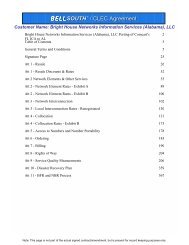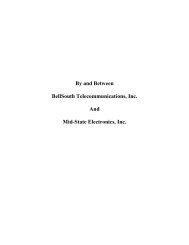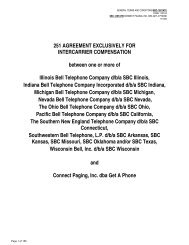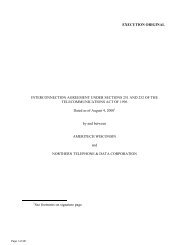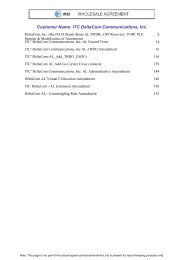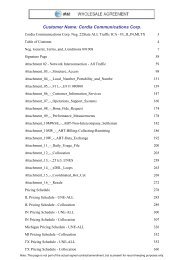Optical Telecommunications, Inc.
Optical Telecommunications, Inc.
Optical Telecommunications, Inc.
Create successful ePaper yourself
Turn your PDF publications into a flip-book with our unique Google optimized e-Paper software.
Version: 2Q05 Standard ICA - New<br />
07/06/05<br />
Attachment 2<br />
Page 19<br />
2.6.1 Where OTI has requested an Unbundled Loop and BellSouth uses IDLC systems<br />
to provide the local service to the End User and BellSouth has a suitable alternate<br />
facility available, BellSouth will make such alternative facilities available to OTI.<br />
If a suitable alternative facility is not available, then to the extent it is technically<br />
feasible, BellSouth will implement one of the following alternative arrangements<br />
for OTI (e.g., hairpinning):<br />
1. Roll the circuit(s) from the IDLC to any spare copper that exists to the<br />
customer premises.<br />
2. Roll the circuit(s) from the IDLC to an existing DLC that is not integrated.<br />
3. If capacity exists, provide "side-door" porting through the switch.<br />
4. If capacity exists, provide "Digital Access Cross-Connect System<br />
(DACS)-door" porting (if the IDLC routes through a DACS prior to<br />
integration into the switch).<br />
2.6.2 Arrangements 3 and 4 above require the use of a designed circuit. Therefore,<br />
non-designed Loops such as the SL1 voice grade and UCL-ND may not be<br />
ordered in these cases.<br />
2.6.3 If no alternate facility is available, and upon request from OTI, and if agreed to by<br />
both Parties, BellSouth may utilize its SC process to determine the additional costs<br />
required to provision facilities. OTI will then have the option of paying the<br />
one-time SC rates to place the Loop.<br />
2.7 Network Interface Device<br />
2.7.1 The NID is defined as any means of interconnection of the End User’s customer<br />
premises wiring to BellSouth’s distribution plant, such as a cross-connect device<br />
used for that purpose. The NID is a single line termination device or that portion<br />
of a multiple line termination device required to terminate a single line or circuit at<br />
the premises. The NID features two (2) independent chambers or divisions that<br />
separate the service provider’s network from the End User’s premises wiring.<br />
Each chamber or division contains the appropriate connection points or posts to<br />
which the service provider and the End User each make their connections. The<br />
NID provides a protective ground connection and is capable of terminating cables<br />
such as twisted pair cable.<br />
2.7.2 BellSouth shall permit OTI to connect OTI’s Loop facilities to the End User’s<br />
customer premises wiring through the BellSouth NID or at any other technically<br />
feasible point.<br />
2.7.3 Access to NID<br />
2.7.3.1 OTI may access the End User’s premises wiring by any of the following means and<br />
OTI shall not disturb the existing form of electrical protection and shall maintain<br />
the physical integrity of the NID:<br />
CCCS 62 of 261




